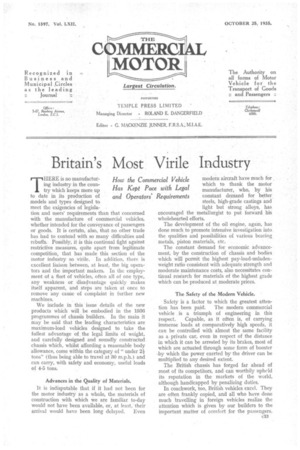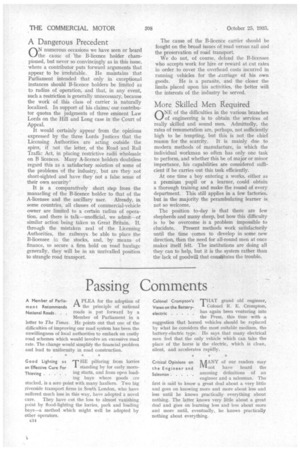Britain's Most Virile Industry
Page 55

Page 56

If you've noticed an error in this article please click here to report it so we can fix it.
THERE is no manufacturing industry in the country which keeps more up to date in its production of models and types designed to meet the exigencies of legisla tion and users' requirements than that concerned with the manufacture of cominercial vehicles, whether intended for the conveyance of passengers or goods. It is certain, also, that no other trade has had to contend with so many. difficulties and rebuffs.' Possibly, it is this continual fight against restrictive measures, quite apart from legitimate competition, that has made this section of the motor industry so virile. In addition, there is excellent liaison between, at least, the big operators and the important makers. In the employment of a fleet of vehicles, often all of one type, any weakness or disadvantage quickly makes itself apparent, and steps are taken at once to remove any cause of complaint in further new machines.
We include in this issue details of the new products which will be embodied in the 1936 programmes of chassis builders. In the main it may be said that the leading characteristics -are maximum-load vehicles designed to take the fullest advantage of, the legal limits of weight, and carefully designed and soundly constructed chassis which, whilst affording a reasonable body allowance, come within the category of" under 2i tons" (thus being able to travel at 30 m.p.h.) and can carry, with safety and economy, useful loads of 4-5 tons.
Advances in the Quality of Materials.
It is indisputable that if it had not been for the motor industry as a whole, the materials of construction with which we are familiar to-day would not have been available, or, at least, their arrival would hay.s been long delayed. Even modern aircraft have much for, which to thank the motor manufacturer, who, by his constant demand for better steels, high-grade castings and light but strong alloys, has encouraged the metallurgist to put forward his wholehearted efforts.
The development of the oil engine, again, has done much to promote intensive investigation into, the qualities and possibilities of various bearing metals, piston materials, etc.
The constant demand for economic advancement, by the construction of chassis and bodies which will permit the highest pay-load-unladenweight ratio consistent with adequate strength and moderate maintenance costs, also necessitates continual research for materials of the highest grade which can be produced at moderate prices.
The Safety of the Modern Vehicle.
Safety is a factor to which the greatest attention has been paid. The modern commercial vehicle is a triumph of engineering in this respect. Capable, as it often is, of carrying immense loads at comparatively high speeds, it can be controlled with almost the same facility as a private car, even in respect of the distance in which it can be arrested by its brakes, most of which are actuated through some form of booster -by which the power exerted by the driver can be multiplied to any desired extent.
The British chassis has forged far ahead of most of its competitors, and can worthily upheld its reputation in the markets of the world, although handicapped by penalizing duties.
In coachwork, too, British vehicles excel. They are often frankly copied, and all who have done much 'travelling in foreign vehicles realize the attention which is given by our builders to the important matter of comfort for the passengers.
A Dangerous Precedent
(IN numerous occasions we have seen or heard V./the cause of the B-licence holder championed, but never so convincingly as in this issue, where a contributor puts forward arguments that appear to be irrefutable. He maintains that Parliament intended that only in exceptional instances should B-licence holders be limited as to radius of operation, and that, in any event, such a restriction is generally unnecessary, because the work of this class of carrier is naturally localized. In support of his claims,' our contributor quotes the judgments of three eminent Law Lords On the Hill and Long case in the Court of Appeal.
It would certainly appear from the opinions expressed by the three Lords Justices that the Licensing Authorities are acting outside the spint, if not the letter, of the Road and Rail Traffic Act, in placing restrictive radii wholesale on B licences. Many A-licence holders doubtless regard this as a satisfactory solution of some of the problems of the industry, but are they not short-sighted and have they not a false sense of their own security It is a comparatively short step from the manacling of the B-licence holder to that of the A-licensee and the ancillary user. Already, in some countries, all classes of commercial-vehicle owner are limited to a certain radius of operation, and there is talk—unofficial, we admit—of similar action being taken in Great Britain. If, throtigh the mistaken zeal of the Licensing Authorities, the railways be able to place the B-licensee in the stocks, and, by means of finance, to secure a firm hold on road haulage generally, they will be in an unrivalled position to strangle road transport. The cause of the B-licence carrier should be fought on the broad issues of road versus rail and the preservation of road transport.
We do not, of course, defend the 13-licensee who accepts work for hire or reward at cut rates in order to cover the overhead costs incurred In running vehicles for the carriage of his own goods. He is a parasite, and the closer the limits placed upon his activities, the better will the interests of the industry be served.
More Skilled Men itequired
ONE of the difficulties in the various branches of engineering is to obtain the services of really skilled and sound men. Admittedly, the rates of remuneration are, perhaps, not sufficiently high to be tempting, but this is not the chief reason for the scarcity. It is mainly due to modern methods of manufacture, in which the individual workman so often has only one task to perform, and whether this be of major or minor importance, his capabilities are considered sufficient if he carries out this task efficiently.
At one time a boy entering a works, either as a premium pupil or a learner, could obtain a thorough training and make the round of every department. This still applies in a few factories, but in the majority the perambulating learner is not so welcome.
The position to-day is that there are few shepherds and many sheep, but how this difficulty is to be overcome is a problem impossible to elucidate. Present methods work satisfactorily until the time comes to develop in some new direction, then the need for all-round men at once makes itself felt. The institutions are doing all they can to help, but it is the system rather than the lack of goodwill that constitutes the trouble.
















































































































































